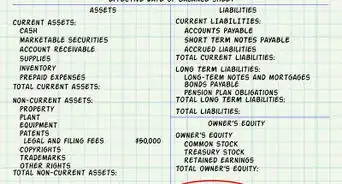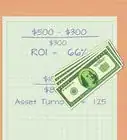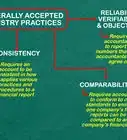This article was co-authored by Alan Mehdiani, CPA. Alan Mehdiani is a certified public accountant and the CEO of Mehdiani Financial Management, based in the Los Angeles, California metro area. With over 15 years of experience in financial and wealth management, Alan has experience in accounting and taxation, business formation, financial planning and investments, and real estate and business sales. Alan holds a BA in Business Economics and Accounting from the University of California, Los Angeles.
There are 8 references cited in this article, which can be found at the bottom of the page.
This article has been viewed 96,429 times.
Businesses and financial analysts calculate asset utilization to assess how efficiently a business is using its assets to create revenue. This measurement is typically calculated as a ratio of asset value to revenues. Asset utilization can be calculated for all of a business's assets at once or for individual categories of assets such as inventory or accounts receivable. Calculating asset utilization is simple if you start with the right information.
Steps
Calculating Asset Turnover
-
1Locate net sales information for the period. Asset utilization can be calculated using any sales or revenue figure. However, the most commonly used number is net sales, which represent the total revenue collected over a period minus any discounts, returns, or allowances for damaged or missing products. This number is typically reported on a business's income statement as "net sales" or simply "sales."
- To find net sales, reduce gross sales by the total amount of all returns, discounts, and damaged or missing goods.[1]
- Determine a period over which you want to measure asset utilization and record the net sales collected in that period.
- For example, a company might have $10,200,000 in sales for a given year. However, they lost $200,000 on returns, discounts, and damages, leaving them with $10,000,000 in net sales.
-
2Calculate average total assets. Average total assets represents the total assets held by the business over the period in which asset utilization is being calculated. It can be calculated by adding the total assets at the beginning of the period plus the total assets at the end of the period and then dividing the total by two. Total assets includes all assets held by the business, including cash and cash equivalents, fixed assets, receivables, and others. Total assets should be stated on the business's balance sheets for each period.[2]
- You can make a more specific analysis of asset utilization by only including assets directly used in production, such as plant equipment and property.
- For example, the company in the previous example might have assets of $7,500,000 at the beginning of the year and $8,500,000 at the end of that year. Their average total assets would then be the sum of the two ($16,000,000) divided by 2, which is $8,000,000.
Advertisement -
3Set up your equation. Asset utilization or, more specifically, asset turnover is calculated quite simply. The formula for asset utilization is . In other words, the formula calculates how many dollars of sales are created per dollar of assets held by the business. Place your data for net sales and average total assets into the equation to calculate asset turnover.[3]
- For the company from the previous example, this would be
-
4Divide to get asset utilization. Solve your equation by dividing net sales by average total assets. Your result will be a number, rather than a dollar amount. Continuing with the previous example, if a company had net sales of $10,000,000 and $8,000,000 in average assets, they would have an asset turnover of , or .[4]
Calculating Other Asset Utilization Ratios
-
1Find your return on assets. Asset turnover is not the only way to calculate asset utilization. Another common measure of roughly the same performance metric is known as return on assets. This ratio compares net income, rather than sales, to total assets. Net income represents the company's profit (their "bottom line") over the period. Calculate return on assets using the following equation: .[5]
-
2Calculate accounts receivable turnover. Accounts receivable turnover is another financial ratio that measures how effective the business is at collecting money it is owed. Use the formula to calculate this ratio. Net credit sales are all sales made on credit minus any returns, discounts, or allowances for damaged or lost goods.[6]
-
3Convert your result to the average collection period. After calculating accounts receivable turnover, you can easily find the average collection period. This represents how long, on average, an amount stays in the accounts receivable account before being collected. Calculate this ratio using the following formula: . A long collection period may mean that the business is susceptible to cash flow shortages.[7]
-
4Determine inventory turnover. Another way to measure asset utilization is to look at how well a business manages its inventory. This can be done by calculating inventory turnover. Calculate this ratio using the following formula: . Cost of goods sold can be found on a business's income statement.
- A small inventory turnover means that the company stores inventory for a longer period of time. This, in turn, increases storage costs and can mean lost sales opportunities.[8]
-
5Find the average age of inventory. Once you have inventory turnover, you can calculate the average age of an item in inventory using the following formula:. This is simply another way of looking at inventory turnover. Like all other ratios, this one can be compared to its historical values over time for the business or to the same ratio for a competing business.
Using Asset Utilization Ratios
-
1Analyze your result. In general, asset utilization is a measure of how well a business is able to utilize their assets to produce revenue. A relatively high ratio means that the company is efficient in using their assets, whereas a low one may indicate poor asset management. How high a specific business's asset utilization ratio should be depends on its industry and stage in its lifecycle. From another angle, a low asset utilization ratio may indicate over-investment in assets.[9]
-
2Compare the result to that of competing companies. Asset turnover is most commonly used to compare the performance of one business or company to that of a competitor or the industry average. Because of operational differences, comparing asset turnover for businesses in different industries does not provide for an accurate comparison. Look for industry asset turnover averages in industry publications or use financial statements from a competing company to obtain figures that you can compare your asset turnover to.
- Asset turnover averages vary widely between industries. Whereas retail companies may have asset turnovers well over 2.00, financial and utilities companies may be close to 0.[10]
-
3Gauge efficiency over time. You can also compare the asset turnover of a business to its own historical asset turnover ratios. Ideally, a business should experience an increasing asset turnover ratio over time, due to either efforts to increase efficiency or economies of scale. Plot asset turnover over several different periods to assess whether or not asset turnover is increasing or decreasing for the business in question.[11]
-
4Use asset utilization as part of a broader analysis. While asset utilization can be useful in assessing business performance, it is not enough to make a complete assessment of the business. You need to combine asset utilization with other measures of performance and risk to determine how well the business is being managed. For example, you can combine asset utilization measures with profit margin and leverage ratios to get an overall idea of the business's performance.[12]
Expert Q&A
-
QuestionWhat is average total assets in accounting?
 Alan Mehdiani, CPAAlan Mehdiani is a certified public accountant and the CEO of Mehdiani Financial Management, based in the Los Angeles, California metro area. With over 15 years of experience in financial and wealth management, Alan has experience in accounting and taxation, business formation, financial planning and investments, and real estate and business sales. Alan holds a BA in Business Economics and Accounting from the University of California, Los Angeles.
Alan Mehdiani, CPAAlan Mehdiani is a certified public accountant and the CEO of Mehdiani Financial Management, based in the Los Angeles, California metro area. With over 15 years of experience in financial and wealth management, Alan has experience in accounting and taxation, business formation, financial planning and investments, and real estate and business sales. Alan holds a BA in Business Economics and Accounting from the University of California, Los Angeles.
Certified Public Accountant Average total assets are the total assets held by a business during a given period of time. The total assets include fixed assets, cash, cash equivalents, receivables, and any other asset.
Average total assets are the total assets held by a business during a given period of time. The total assets include fixed assets, cash, cash equivalents, receivables, and any other asset. -
QuestionWhat is the formula for average total assets?
 Alan Mehdiani, CPAAlan Mehdiani is a certified public accountant and the CEO of Mehdiani Financial Management, based in the Los Angeles, California metro area. With over 15 years of experience in financial and wealth management, Alan has experience in accounting and taxation, business formation, financial planning and investments, and real estate and business sales. Alan holds a BA in Business Economics and Accounting from the University of California, Los Angeles.
Alan Mehdiani, CPAAlan Mehdiani is a certified public accountant and the CEO of Mehdiani Financial Management, based in the Los Angeles, California metro area. With over 15 years of experience in financial and wealth management, Alan has experience in accounting and taxation, business formation, financial planning and investments, and real estate and business sales. Alan holds a BA in Business Economics and Accounting from the University of California, Los Angeles.
Certified Public Accountant Start by adding up all of the assets at the beginning of the period you're calculating for. Then, add up all of the business' assets at the end of the period. Finally, divide by 2.
Start by adding up all of the assets at the beginning of the period you're calculating for. Then, add up all of the business' assets at the end of the period. Finally, divide by 2.
References
- ↑ http://www.investopedia.com/terms/n/netsales.asp
- ↑ Alan Mehdiani, CPA. Certified Public Accountant. Expert Interview. 9 July 2020.
- ↑ https://ycharts.com/glossary/terms/asset_utilization
- ↑ http://www.investopedia.com/terms/a/assetturnover.asp
- ↑ http://www.netmba.com/finance/financial/ratios/
- ↑ https://www.reference.com/business-finance/asset-utilization-df7db79f270ebcac
- ↑ https://www.reference.com/business-finance/asset-utilization-df7db79f270ebcac
- ↑ https://www.vendhq.com/blog/inventory-turnover/
- ↑ http://www.uofentrepreneurship.com/utilization.html

















































































